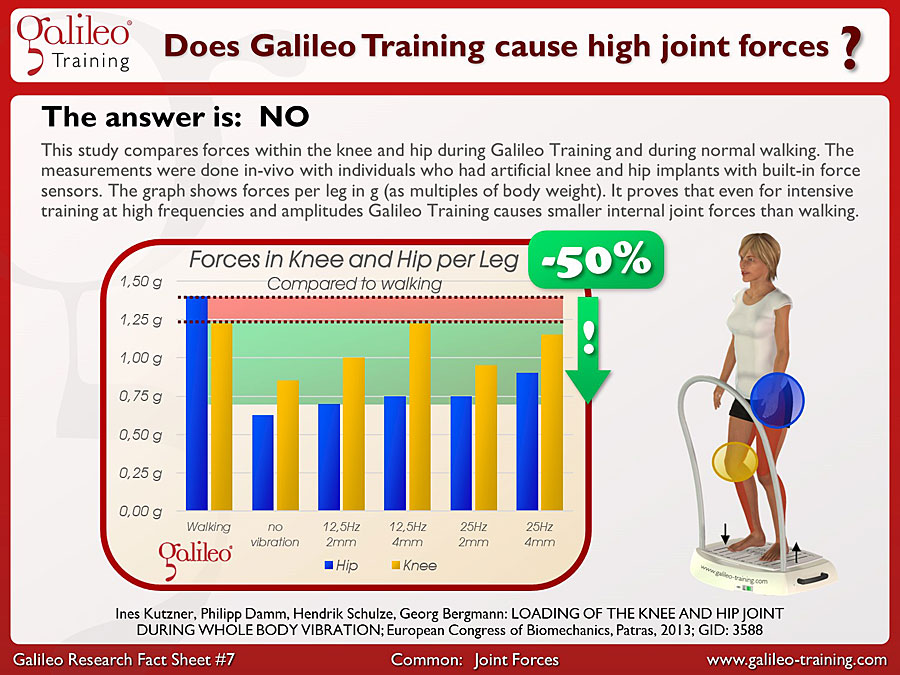Galileo Research Facts No. 7: Does Galileo Training cause high joint forces?

One observation which is quite astonishing: Although Galileo Training can activate the muscles to their maximum the forces between the feet and the platform as well as the forces in the hip or knee joints are less than in walking (#GRFS160). This is one of the reasons why Galileo Training provides such a safe workout.
On first sight this might be hard to believe – however, when looking in detail, these measurement results make sense because of several basic rules of physics:
Fist of all: It is essential that the Galileo movement as patented in 1996 is based on side-alternation. Meaning: when one side goes up the other goes down – and this in a fast rhythm (Frequency in Hz = repetitions per second). Therefore, the Galileo movement mimics human gait (oscillating from one leg to the other). All muscle of the muscle chain used for walking (from the ancle joint to the muscles of the upper back) have therefore to be activated (and most important have to work together) per repetition to be able to react to the movement of the platform. Important point is that this is happening side-alternating: while one side is activated (“loaded”) the other side is deactivated (“unloaded”) – meaning part of the bodyweight is constantly shifted from one leg to the other.
Second: The typical application of Galileo is in symmetric standing – meaning without vibration half (59%) of the bodyweight is loaded to each leg. Compared to typical movements like walking the Galileo plate creates only a very small displacement (in this study +/-2mm and +/-4mm). Since our body is flexible and not stiff as a steel rod, the maximum force depends mainly on the extent of displacement (2mm or 4mm from the neutral position) and the body stiffness.
In addition, essential for the effects acting on the body is the mechanics of the Galileo device, because its mechanics provide a mechanically guided movement of the pure harmonic (sinusoidal) movement – meaning: without harsh impacts and resulting short force peaks. Now, when both feet are in ground contact, the maximum unloading (assuming 50% body weight per leg in symmetric standing (=static component)) can be 50% body weight, and as a consequence also the maximum addition loading (=dynamic component) can also be only 50% body weight (due to the harmonic movement of the plate). Hence, maximum load is 100% body weight per leg which is equivalent to quiet standing on one leg. Typically, the dynamic forces are in the range below 30% and therefore maximum forces are below 80% of body mass. As a comparison: peak forces during typical walking on even ground are at about 120% of body weight. Galileo application is therefore not only easy on joints but also very easy to adjust simply by changing foot position: the closer the feet the less movement and the less “intensive” is Galileo application , #GRFS111).
Most other vibration plates use much different mechanics: Either they move both sides up and down (vertical vibration) at the same time (both feet, hip and spine are loaded and therefore compressed at the same time, and hence the typically unpleasant transmission to the head is much larger #GRFS2, #GRFS6). Or as all inexpensive devices they use a light-weight, one-side driven plate without internal force compensation. This result with increasing frequency to an increased movement of the device itself (often sucking feet are used to prevent the device from moving around the floor) and when loaded (during exercises) the foot-plate is prone to elastically bending. Both effects result in additional impact-like movements/force components which feal unpleasant at the same time. When comparing a Galileo device next to other devices this can easily be tested – the Galileo just “feels” much different.
As can be seen: vibration is not vibration, because the type as well as the quality of the movement is essential. Therefore, high quality and most of all well-designed mechanics are the key component (and also the key factor for production costs). For Galileo a concept which has already be addressed by his inventor Hans Schiessl in his original patent form 1996 and which turned out to be just on the point – even after all those years – and numerous international studies prove his concept year by year by year…
#GRFS7 #GalileoTraining #GalileoResearchFacts #WholeBodyVibrationTraining #MechanoStimulation #JointForces #GalileoSafety
- Produktgruppen: Galileo Therapy, Galileo Training
- Themen: Athletics, Back, Back Pain, Diseases, Fit Aging, Fitness at Home, Fitness at the Gym, Fitness at Work, Geriatrics, Health Promotion at Work, Incontience, Medical Applications, Neurological Conditions, Orthopedic Diseases, Osteoporosis, Paediatrics, Pelvic Floor, Prevention, Pyhsitherapy & Rehabilitation, SCI, Stroke, Therapy & Prevention using Galileo, Training & Education, Training for Kids, Training with Galileo, Wellness & Beauty